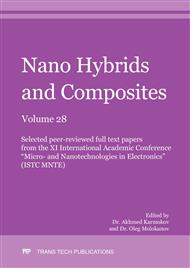[1]
V.M. Mukhortov, Yu.I Yuzyuk, Heterostructures based on nanoscale ferroelectric films: production, properties and applications, Rostov-on-Don: Southern Scientific Center of RAS, (2008).
Google Scholar
[2]
M. Kim, B. Hwang, J. Jeong, N.K. Min, K.H. Kwon, Micromachining of a bimorph Pb(Zr,Ti)O3 (PZT)cantilever using a micro-electromechanical systems (MEMS) process for energy harvesting application, J. Nanosci. Nanotechnol. 12 (2012) 6011–6015.
DOI: 10.1166/jnn.2012.6365
Google Scholar
[3]
J. Hong, H.W. Song, S. Hong, K. No, Fabrication and investigation of ultrathin, smooth Pb(Zr,Ti)O3 films for miniaturization of microelectronic devices, J. Appl. Phys. 92 (2002) 7434-7441.
DOI: 10.1063/1.1524307
Google Scholar
[4]
A.A. Rozhko, V.V. Petrov, A.S. Kamentsev, Yu.N. Varzarev, Energy converter on thin ferroelectric films, Proceedings of Twenty Seventh International Scientific-Technical Conference Safety Systems – 2018,. Moscow, Academy оf State Fire Service, (2018) 229-232.
Google Scholar
[5]
D.A. Kovalenko, V.V. Petrov, Development of sensors based on ferroelectric films for hybrid sensor systems, Engineering journal of Don, 4 pt.2 (2012).
Google Scholar
[6]
Liu W.G., Sun L.L., Zhu W.G., Tan O.K. Noise and specific detectivity of pyroelectric detectors using lead titanate zirconate (PZT) thin films, Microelectron. Eng. 66 (2003) 785–791.
DOI: 10.1016/s0167-9317(02)01000-6
Google Scholar
[7]
J. Denga, W. Zhua, O.K. Tana, X. Yaoba, Amorphous Pb(Zr,Ti)O3 thin film hydrogen gas sensor, Sensors and Actuators, 77 (2001) 416-420.
DOI: 10.1016/s0925-4005(01)00707-9
Google Scholar
[8]
C.R. Bowen, V.Yu. Topolov, H.A. Kim, Modern piezoelectric energy-harvesting materials, Springer International Publishing, (2016).
Google Scholar
[9]
V.V. Petrov, Harvester of Energy on Pb(Zr,Ti)O3 Thin Films, Proceedings 4 (2019) 40 (1-4).
Google Scholar
[10]
D.A. Kovalenko, V.V. Petrov, Researches of the Internal Mechanical Stresses Arising in Si-SiO2-PZT Structures, J. Nano- Electron. Phys., 7, 3 (2015) 03036.
Google Scholar
[11]
S. Xiong, H. Kawada, H. Yamanaka, T. Matsushima, Piezoelectric properties of PZT films prepared by the sol–gel method and their application in MEMS, Thin Solid Films, 516 (2008) 5309–5312.
DOI: 10.1016/j.tsf.2007.07.085
Google Scholar
[12]
Gatabi J.R., Rahmana S., Amaro A., Nash T., Rojas-Ramirez J., Pandey R.K., Droopad R. Tuning electrical properties of PZT film deposited by Pulsed Laser Deposition//Ceramics International. V. 43, Is.8, 2017, P. 6008-6012.
DOI: 10.1016/j.ceramint.2017.01.139
Google Scholar
[13]
D.A. Kovalenko, V.V. Petrov, V.G. Klindukhov, Investigation of the influence of technological parameters of the formation of lead zirconate titanate thin films on their structural and electrophysical properties, Izvestiya SFedU. Engineering Sciences, 9(158) (2014) 124-132.
DOI: 10.18522/2311-3103-2016-10-1219
Google Scholar
[14]
D.A. Kovalenko, V.V. Petrov, The study of the morphology of the surface of ferroelectric films of lead zirconate-titanate and their chemical composition, Izvestiya SFedU. Engineering Sciences, 8(169) (2015) 203-213.
DOI: 10.18522/2311-3103-2016-10-1219
Google Scholar
[15]
A. Genie, X-ray diffraction of crystallites. Theory and practice. – Moscow, (1961).
Google Scholar
[16]
C.D. Sawyer and C.H. Tower. Rochelle salt as a dielectric, Physical Review, 35 (1930) 269-273.
DOI: 10.1103/physrev.35.269
Google Scholar
[17]
D.V. Stryukov, V.M. Mukhortov, S.V. Biryukov, Yu.I. Golovko,. Field effect in metal -ferroelectric-semicondu ctor structure with multilay er ferroelectric. Science in the South of Russia. 13(1) (2017) 18–24.
DOI: 10.23885/2500-0640-2017-13-1-18-24
Google Scholar
[18]
A.V. Pavlenko, N.V. Lyanguzov, N.V. Novikovsky, V.G. Smotrakov, A.P. Kovtun, Synthesis, structure and dielectric properties of PbMg1/3Nb2/3O3 ceramic and thin films on Si(001) substrates, Science in the South of Russia. 13(3) (2017) 27–33.
DOI: 10.23885/2500-0640-2017-13-3-27-33
Google Scholar


